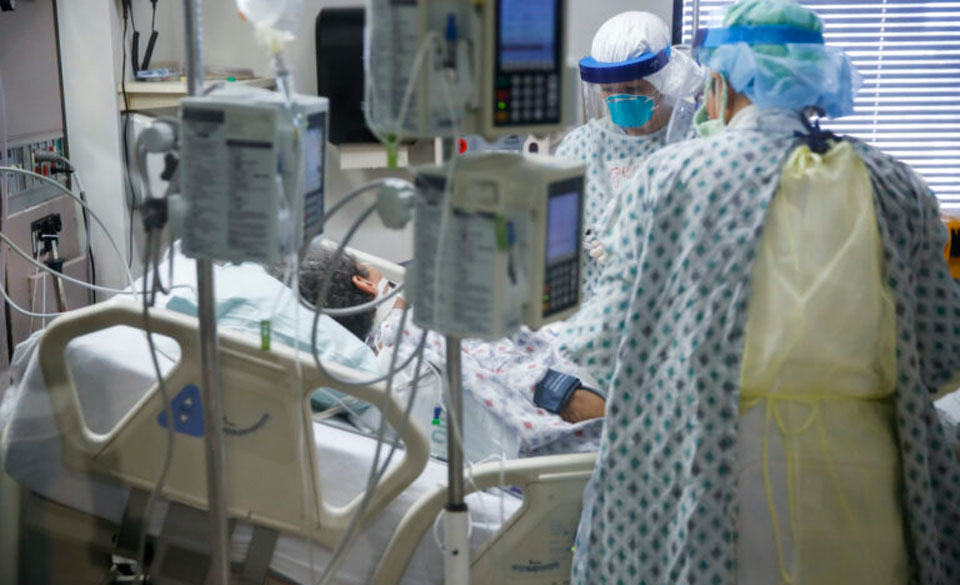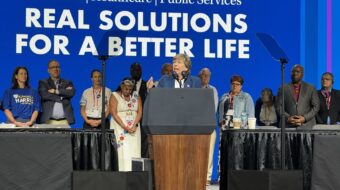
WASHINGTON—It may be no great surprise, especially to unions in the front lines of defending workers against the ravages of the coronavirus, but a comprehensive report by the Labor Department’s own Inspector General reveals the Occupational Safety and Health Administration was hamstrung in the fight against the plague.
And while Carolyn Hantz, the Deputy Inspector General for Audit, doesn’t name names, it doesn’t take much thinking to conclude who was responsible for OSHA’s inaction in the first 54 weeks since the nation was hit with the pandemic, which has killed 550,955 people since.
Hantz’s report not only paints a devastating portrait of what happened at OSHA as the coronavirus swept the nation in the spring and summer of 2020. It also has four recommendations for what OSHA should do to reverse course.
One on the list: An immediate Emergency Temporary Standard ordering firms to develop and implement plans to protect workers against the virus—a demand unions have made for months, even unsuccessfully in court. And National Nurses United was campaigning for such a standard even before the government officially declared the pandemic began.
Meanwhile, buried in Hantz’s report is a written statement by Lauren Sweatt, a Trump political appointee and then OSHA’s top official, that “working on a formal rulemaking at the same time the health care industry” in particular “is responding to a public health emergency is counterproductive to both the public health and to stakeholder engagement.
“The efforts employers would make to document compliance with such a standard would distract them from other vital compliance activities,” she wrote lawmakers last March 18.
Workers, unions, the AFL-CIO and especially National Nurses United, don’t see that.
Nurses confident
“Nurses are confident we can care for Covid-19 (coronavirus) patients, and even help stop the spread of this virus IF we are given the protections and resources we need to do our jobs,” Bonnie Castillo, RN, the union’s executive director, said last March 5, at the release of the first of a series of NNU surveys of nurses about coronavirus conditions on the job.
Hantz paints a devastating picture of how the nurses, and other workers, weren’t given the protections they demand. Overall job safety and health complaints rose by 15%, to 23,447. in the first six months of the pandemic in 2020, compared to those same six months in 2019.
But in those same months, on-site OSHA inspections for any job safety and health violations—of any type, not just if firms protected workers against the virus—declined 50%, from 26,174 to 13,010.
Even when it inspected, OSHA didn’t have much of a cudgel against violators, Hantz noted. Its “guidance” about protecting workers against the virus lacks the force of law. Even with the guidance in hand, which OSHA inspectors could use as evidence to determine later violations of job safety and health regulations, OSHA didn’t push very hard.
“Internal guidance used to assist with enforcement during the early months of the pandemic did not emphasize the need to increase Covid-19 inspections for very high or high-risk health care workers or workers in other industries who were dying or falling ill,” she reported.
And if inspectors stopped going to job sites, mostly because doing so was dangerous due to the risk of the pandemic, and spreading the virus, they also stopped citing firms.
Health care specialist Dulce Castaneda, daughter of a veteran Smithfield meatpacking plant worker in Crete, Neb., told lawmakers in March what conditions were like when OSHA didn’t come calling: Inspectors took a company’s word for it that it was protecting workers.
“OSHA closed my complaint because, according to the official I spoke with, there was nothing to indicate an inspection needed to happen,” she told the House Appropriations Labor-HHS subcommittee.
“He instructed me to tell my father to ‘wear his mask and keep his distance.’ He was referring to the same company that issued its workers hairnets to use as face masks and that refused to implement social distancing in work areas–a company proven to be irresponsible in its handling of the coronavirus.”
“Much like how Smithfield blamed the spread of Covid-19 on its workers’ living conditions, OSHA did the same. OSHA decided the company was in compliance without doing an inspection or talking to workers. However, workers don’t set the working conditions.”
Instead of enforcement and writing up violations, Hantz said, OSHA inspectors, doing most of their work by phone, fax or computer and relying on company-produced evidence, “issued hazard alert letters and alerted employers about specific industry hazards” from the virus “and how to protect workers against it.”
Hantz reported that without a specific OSHA standard firms must follow, or be cited for breaking, inspectors must fall back on its catch-all “General Duty Clause” requiring companies to fulfill a “general duty” to protect their workers. It’s rarely used, even without a pandemic. An Emergency Temporary Standard, as NNU demanded, is even rarer. The last one was in 1983.
Invoked General Duty Clause
In fiscal 2018, which ended Sept. 30, 2018, OSHA inspectors invoked the General Duty Clause 883 times to cite firms for violating worker safety and health. OSHA followed that with 829 General Duty Clause violations in fiscal 2019. By contrast, OSHA inspectors cited firms more than 62,000 times each year for breaking sector and job-specific safety standards.
And in the first six calendar months of the pandemic, from Feb. 1-Oct. 26, 2020, OSHA inspections overall dropped. There were 295 inspections for coronavirus violations, despite almost 10,000 complaints. General Duty Clause violations of coronavirus guidance? Three.
“According to IG interviews, officials in OSHA area offices mostly agreed an ETS (emergency temporary standard) would be useful during an inspection. An area office official acknowledged the General Duty Clause is harder to cite, and having a standard would make it easier issuing citations” for not protecting workers against the virus, Hantz stated.
States, particularly Michigan, California, Virginia, and Oregon, did a far better coronavirus inspection and citation job, Hantz reported. They imposed their own emergency standards. They also enforced them. Though Hantz didn’t say so, all four are Democratic-run.
The 22 states with their own OSHAs covering all worksites, and the six more whose OSHAs cover only government workers, carried out 756 actual coronavirus-related company inspections and uncovered 1,679 violations, and that included none in Maine. Meanwhile, OSHA had discovered 295 violations in 176 physical inspections of coronavirus complaints.
Its first three went to the same Ohio nursing home, on July 3, “after the company reported hospitalization of seven employees,” Hantz drily reported. That’s three months after the pandemic declaration.
By contrast, “While most Michigan job providers are doing their part to slow the spread of Covid-19, these rules provide them with clarity to keep their workplaces safe and their employees healthy,” Gov. Gretchen Whitmer, D-Mich., stated when unveiling its standards.
Oregon’s emergency temporary standard covers not just health care workers, but “restaurant, retail, construction, and other general industry employees,” Hantz noted. Oregon’s temporary standard expires May 4, but the state is working on making it permanent.
And the four states also require firms to notify state and local public health departments of coronavirus outbreaks and quarantines. Oregon and California have extra standards for firms in high-risk sectors, notably health care. The tougher state standards produce results.
A summary on what OSHA’s role should be—but what its performance under the Trump regime wasn’t–came from Deborah Berkowitz, a top Obama-era OSHA official who is now safety and health director for the National Employment Law Project.
“Workplace exposures to Covid-19 could be and are a significant driver of the pandemic,” Berkowitz testified at the same hearing where Castaneda spoke. “To mitigate the spread of Covid-19 to the public, we must also mitigate the spread of Covid-19 in the workplace. All communities are at risk when workers are not protected.
“Protecting workers is not just a legal and moral imperative. It’s an economic and human rights imperative.”












Comments